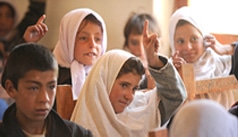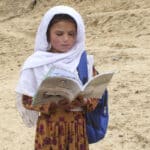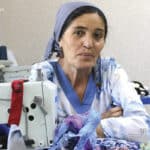What About the Boys? Educating Boys is Still Important in Developing Countries
Educating girls in developing countries has been the focal point of NGOs and charity organizations for many years. The UN highlighted girls’ education in both the 2000 Millennium Development Goals and the 2015 Sustainable Development Goals. While these goals include educating boys too, they call out the disparity in gender specifically. CAI also singles out girls’ education as an important focus in our mission, noting that girls face higher social and economic barriers to education than boys in the countries where we work.
Why Does Educating Boys Take a Back Burner?
These organizations put heavier weight on girls’ educations for several reasons, mostly because girls face higher barriers to education than boys around the world. The UN reports that, “103 million youth worldwide lack basic literacy skills, and more than 60 percent of them are women.” Many times families will only have the resources for one or two children to go to school, and often they will send the boys instead of the girls.
Global Partnership for Education reports, “Girls are 1.5 times more likely than boys to be excluded from primary school. That’s 15 million girls of primary school age who will never have the opportunity to learn to read and write in primary school, compared to about 10 million boys.”
Educated girls and women are also more likely than boys to share that education with their families and communities, and the children of educated mothers have a 50 percent greater chance of living past age five and a 50 percent greater chance of going to school themselves.
With all this focus on educating girls, many people are left wondering, “What about the boys? Isn’t educating everyone important?” The answer is a resounding yes. Educating both boys and girls around the world matters in creating global sustainability and peace.
The Benefits of Educating Boys
Close to 30 percent of the students CAI serves are boys. In many of the rural areas where we work, access to education for everyone is a challenge. In fact, education rates in the countries we serve are dire—the adult literacy rate in Afghanistan is only 31 percent, and it jumps to 55 percent in Pakistan, as reported by UNESCO. These countries also have incredibly young populations, so educating as many children as possible means the next generation of leaders will have the skills they need to lead their countries, whether they are male or female.
Another benefit to educating boys along with girls is the effect on gender inequality. When boys grow up learning alongside their sisters, they learn that women deserve the same opportunities and respect as men.
“Education provides an important opportunity to engage boys within learning environments to challenge gender inequality and encourage them to view girls as equal partners in education and life,” says a report by UKAID.
CAI board member, Nasrine Gross, has known this for many years. She runs Kabultec in Afghanistan, an organization that provides literacy training to adult men and women. The primary project of the organization is providing free literacy classes to married couples.
In an interview with CAI about the program she says, “I thought if I do just women, most of the men are illiterate too. So in the household it may not be such an effective way. I said if I do only the husbands then the women will continue to be bypassed. So why not bring both of them? And I knew, another thing, that most Afghan men are not against education with their wives or their daughters or their children. And we’ve never had any problems with them.”
Poverty is a Barrier for Many Boys
For many of these men and boys, poverty is the main barrier to achieving access to education. Sometimes families don’t have enough money to send any of their children to school. The parents are illiterate and may not realize the importance of educating their children. Without help, many of these boys are destined to continue the cycle of poverty and illiteracy, working for the family at a young age instead of going to school. Without the ability to read, they can never read laws, deeds, or newspapers and will rely on the word of others without the ability to see for themselves.
This is why CAI supports education for all. Akbar Ali is one of those boys who would have faced limited opportunity without help from CAI. He is from one of the most northern areas in Gilgit- Baltistan and his father was a sanitation worker, not earning enough to send his son to school.
Through CAI he was awarded a scholarship to attend the Tameer-e-Millat Community School. Through determination and hard work he consistently finished at the top of his class, and after grade five he earned additional scholarships to study. After attending the Army Public School Ghanche, he won a full scholarship from the Pakistan Army for his secondary education. Without the educational foundation provided by CAI, he would never have been able to realize his potential.
“I am very thankful to CAI management for their continuous support, to all teaching staff and the school who provided me an initial platform for strong foundation in my poor days,” he says. “I am committed to support the mission of CAI in the remote areas of Pakistan.”
While efforts to educate these remote villages and developing countries may continue to focus on creating equal opportunities for girls, boys’ education is still important. There is still work to be done before the majority of children can access education worldwide and literacy is universal. CAI will continue to work to ensure that girls and boys receive the skills they need to change the world for the better.












7 responses to “What About the Boys? Educating Boys is Still Important in Developing Countries”
Good article. Thank you!
I have often wondered about this. Thank you for clarifying your educational goals for kids, including boys.
In most African countries it is the boys that goes to school and girls stay at home to help with the cleaning and cooking. But that is changing. The percentage of girls and boys are up 18% in parts of Africa.
I like your balance strategies for both boys and girls . Indeed, boys too suffer dropping from school. ….
In my country, Sierra Leone, both boys and girls dropping from school as a result of poverty. …..for real many girls are dropping from school because of poverty, teenage pregnancy, early marriage etc… I will share of our work experience. ….
Thanks
RICHARD. ..CEO…FORD..ORGANIZATION
Thanks for sharing about the boys also.. All should get a good education!
Great article.Thank you for considering empowerment of boy child through education..Only when we empower both boys and girls,we shall get a justified society.#ISTANDFORBOYCHILD#
I’ll use the for my debate on Friday